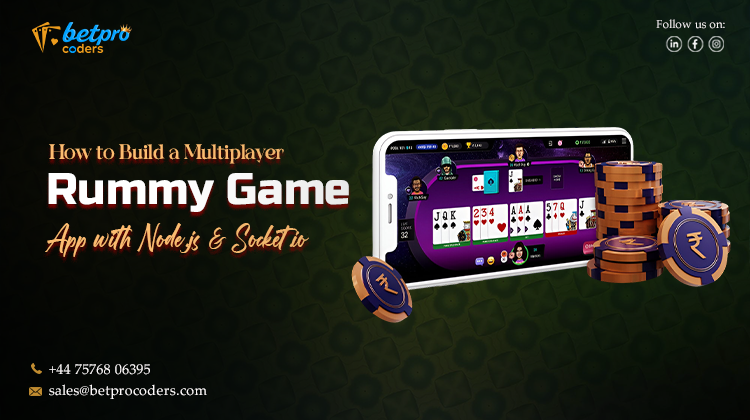Rummy has always been a classic among online card games, and there were more than 50 million active players playing Rummy online across platforms. Multiplayer card gaming experiences are at an all-time high. If you’re a game developer or a business that is looking to launch your own multiplayer rummy platform, then you must build a Rummy Game with Socket.io and Node.js, which will be one of the best technology choices to make in 2025.
These technologies offer powerful real-time communication, subset multiplayer communications, and server performance, paramount in building a rummy game that is scalable, fast, and fun. Further, this post is entirely based on a guide to develop a multiplayer rummy game with Node.js & Socket.io. Let’s start it.
Contents
- 1 What Is A Rummy Game?
- 2 Understanding Your Target Audience And Market
- 3 Why Choose Node.js And Socket.io For Multiplayer Rummy Games?
- 4 Steps to Build a Multiplayer Rummy Game App with Node.js & Socket.io
- 4.1 Step 1: Planning The Rummy Game Architecture
- 4.2 Step 2: Designing UI/UX
- 4.3 Step 3: Setting Up The Development Environment
- 4.4 Step 4: Creating The Game Engine & Backend Logic
- 4.5 Step 5: Building The Frontend Application
- 4.6 Step 6: Integrate Multiplayer Features And Fair Play
- 4.7 Step 7: Testing Your Multiplayer Rummy Game
- 4.8 Step 8: Deployment And Scaling
- 4.9 Step 9: Marketing And Monetization
- 5 Technical Foundations For Building A Rummy Game (Expanded)
- 6 Challenges And Advanced Solutions In Multiplayer Rummy Game Development
- 7 Future Trends Of Rummy Game App with Node.js & Socket.io (Enhanced)
- 8 Conclusion
- 9 FAQs
What Is A Rummy Game?
Rummy is a family of matching card games created and played universally. The aim of Rummy is to create valid sets and sequences from the 13 cards you are dealt. The main focus is to minimize the points in hand by combining your cards into melds.
Now, in the digital space, Rummy apps have turned casual gaming into competitive gaming. Players can enter real-time rooms, play with friends as well as strangers, play in tournaments, and win real money. Rummy features several types of games, including Point Rummy, Pool Rummy, and Deal Rummy, and provides a very adaptable gaming experience to a variety of demographics.
Understanding Your Target Audience And Market
When you know who you are building for, you can make better decisions around features, tech stack, user experience, and monetization strategies. That’s why understanding the audience’s patterns, needs, and expectations is paramount before embarking on Rummy game development.
Key Audience Segments
1. Casual Gamers
These audience members want short game sessions and easy onboarding with simple ceilings. Your aim should be load times in seconds, guest login, and push notifications to enhance retention.
2. Competitive Players
These are players who want real money tournaments and an in-depth leaderboard. You can’t skimp on security, meaning anti-fraud and/or fake accounts, a rock-solid scoring engine with fast, accurate point calculation, a real-time sync engine, and verified payment gateways.
3. Regional Language Users
These are primarily individuals from Tier-2/3 cities who want content available in their preferred language. For them, adding vernacular UI, vernacular avatar customizations, and voice prompts in their chosen regional language is critical.
4. Social Gaming Enthusiasts
These gamers enjoy the gaming community culture. They need to engage with a private table, an invite link, emoji/chat features, and friend vs. friend ladders.
Why Choose Node.js And Socket.io For Multiplayer Rummy Games?
If you’re building a real-time Rummy game, Node.js and Socket.io are going to be two technologies you won’t be able to avoid on your whiteboard. These are the main reasons they work well together:
1. Simple Real-Time Communication
Socket.io allows for real-time, bi-directional communication between the server and the client. That is important for card games because card games require concurrency, especially when it comes to turn-taking, shuffling, and scorekeeping, all of which need to be real-time and in sync for all users.
2. Non-blocking Code
Node.js is non-blocking, and it is event-driven rather than thread-based. It also allows you to control thousands of players at once, which is ideal for big tournaments, players versus players, and large public rooms.
3. Lightweight But Powerful
Node.js + socket.io = high performance with low resource consumption. No bloated infrastructure is needed.
4. Simple Integration
Node.js can easily slip into the backend of many frontend engines, including Phaser.js, React, or Unity, and Socket.io also pieces together communications between devices and servers.
5. Cross-Device Compatibility
Both Node.js and Socket.io don’t care what the underlying OS is. Users on Android. iOS User. Users in a desktop browser. On the outside, your game can bring the same real-time magic.
6. Community & Libraries
You will not lack support from NPM modules to GITHUB plugins. The support ecosystem is plentiful. You will not be idle for long when building a Rummy App Development using Node.js.
Read Also: Top 20 Rummy Game Development Companies in India 2025
Steps to Build a Multiplayer Rummy Game App with Node.js & Socket.io
Developing a Multiplayer Rummy Game with Node.js & Socket.io is a step-by-step approach. Let’s map it out:
Step 1: Planning The Rummy Game Architecture
Outline your core game logic and state management, server roles (like matchmaking, scoring, and chat), and your API structure. Plan how players will be joining rooms, how cards will be dealt, and how you are going to progress rounds.
Step 2: Designing UI/UX
The UI/UX must be easy to use and intuitive. Use wireframing tools such as Figma or Adobe XD to draw out every single screen. Pay very careful attention to card animations, user flows, lobby design, and button placements if you want an intuitive user experience.
Step 3: Setting Up The Development Environment
Install Node.js, Socket.io, and any other dependencies. You will want to use Express.js as your backend framework. For your game state management, you could use MongoDB or Redis.
Step 4: Creating The Game Engine & Backend Logic
Here, you should have user authentication ready, distribution of cards, creation of the room, and defined game rules. You will have to put players into Socket.io rooms or create a lobby for game actions. Further, if you’re looking for a more hands-on approach, consider following a dedicated Socket.io Rummy Game tutorial.
Step 5: Building The Frontend Application
You can use React, Vue, or Phaser for the frontend application. The main point is that the frontend application also needs to capture the different Socket events, update the application, and render it back instantly.
Step 6: Integrate Multiplayer Features And Fair Play
Implement public and private game rooms, matchmaking, and score handling features while combining RNG (Random Number Generators) for shuffling cards and ensuring fair play is also handled in this step.
Step 7: Testing Your Multiplayer Rummy Game
Carry out testing under simulated load through tools like Artillery or JMeter. Perform multiplayer stress tests and security penetration tests.
Step 8: Deployment And Scaling
Deploy your backend on AWS, Google Cloud, or Heroku. Use Docker for containers and NGINX for a reverse proxy. Make sure that your application is scalable horizontally to handle sudden surges in traffic.
Step 9: Marketing And Monetization
Use ASO (App Store Optimization) to reach new players, run referral campaigns, and offer incentives for completing daily challenges. Monetize through in-app purchases, banner advertising, or entry fee pay-to-play tournaments.
Technical Foundations For Building A Rummy Game (Expanded)
For a multiplayer rummy game to succeed, all the technology choices need to be in harmony, as there is an impact on performance and reliability.
Let me outline all the bits and pieces:
1. Node.js (Server)
This is the real-time component in our application because Node.js is a non-blocking and event-driven server, which can support a significantly high level of responsiveness while serving many game tables at the same time. Further, Node.js is highly suitable for a real-time Rummy game Node.js app handling thousands of concurrent players with minimal latency.
2. Socket.io (WebSockets)
Socket.io extends HTTP to support two-way, event-based communication between the server and clients. It also allows us to affect card distribution, turn timers, in-game chat, and live score updates.
3. MongoDB (Database)
MongoDB is used to store user profiles, transaction information, game history, and leaderboards. The database is schema-less and could be used to add new site features such as themed tables, avatars, or regional leaderboards.
4. Redis (Cache & Session)
Redis is primarily suitable for tracking real-time game sessions and other frequently accessed data. It also provides pub/sub technology to allow Node instances to communicate together in a distributed format.
5. Frontend Frameworks (React.js, Vue.js, Phaser.js)
React and Vue are focused on building slick UI components by component, while Phaser.js is focused on building canvas-type animated card layouts. In general, smooth animations (drag-and-drop cards, flip effects, etc.) will increase engagement.
6. Docker + Kubernetes
Docker gives you version control and portability. Kubernetes adds another layer of functionality, if that’s a path you might be led down, including automatic scaling, load balancing, health checks, and switch recovery.
Read Also: How To Develop An Incredible Card Game App like Rummy Circle
Challenges And Advanced Solutions In Multiplayer Rummy Game Development
Developing real-time multiplayer rummy games presents a few nuanced challenges. Here is a breakdown of the challenges and alternative resolutions:
Real-Time Sync Errors
- Challenge: Lag, redundant moves, and timing issues.
- Resolution: Use Socket.io room acknowledgment for every move, and give a time stamp for each move on server validation before broadcasting it to the client or clients. Enable client-side buffering to compensate for minor jitter and then reconcile against the server state.
Player Drop Out
- Challenge: Unforeseen dropouts create fairness issues.
- Resolution: Identify a reconnection window (30–60 seconds). If the player does not reconnect, then allow automated AI bots to replace them and play in their stead. In the meantime, store reconnection tokens in Redis, which allows returning players to efficiently restore game state when they reconnect.
Cheating and Card Manipulation
- Challenge: Abuse of card ordering or revealing hidden cards.
- Resolution: Perform all random shuffling and dealing server-side with a strong RNG. You could use an HMAC or hash to securely track deals. Periodically, audit the RNG logic, and if warranted, consider using a provably fair system.
Scaling rooms with thousands of players
- Challenge: State and load management with large user numbers.
- Resolution: Keeping the room state in Redis. Deploy multiple Node.js containers using Kubernetes and use Redis pub/sub to push events across the containers, maintaining the state of all individual game instances.
For Free Consultation
Contact Number: +447576806395
Email: [email protected]
Future Trends Of Rummy Game App with Node.js & Socket.io (Enhanced)
The future of digital Rummy has never looked brighter. Here’s a look ahead at the trends you can expect to see:
1. AI Bots & Intelligent Matchmaking
Apply machine learning to assess players’ behaviors to develop intelligent bots that can identify patterns of play and match similar players with Elo and dynamic Elo systems, creating even greater fairness and competitive playing conditions.
2. Voice and Video Chat Integration
Build real-time communication and interaction into your game using WebRTC for voice or video. This adds a high degree of social interaction, which is a perfect addition for friends playing together or players in private rooms. Don’t forget to consider moderation and noise filters to keep both the players’ privacy intact and your quality control in play.
3. AR Gameplay
AR SDKs like ARCore and ARKit now allow developers to create AR experiences that will change the way virtual card tables are projected onto a real-world surface. Players will experience new interactions with 3d cards, hand gestures, and spatial audio, which will result in an innovative and immersive rummy experience.
4. Blockchain & NFT Integration
Smart contracts can track ownership of in-app assets, and assets can be transferred, allowing for full ownership. Secure crypto wallets would allow for decentralized transactions and would be accessible all over the world.
Read Also: Calculate the Rummy Game App Development Cost with Features
Conclusion
Creating a Multiplayer Rummy Game with Node.js & Socket.io is a rewarding undertaking because it brings together real-time communication, powerful backend logic, engaging UI/UX design, and revenue opportunities. Every aspect, from considering how your architecture is structured to debugging your application under high-load scenarios, is important.
If you’re looking for a skilled development agency to work with, BetPro Coders is a trusted Rummy Game Development Company that delivers full-cycle services from online multiplayer engine development to analytics and licensing.
FAQs
1. Which frontend framework works best with Socket.io for real-time game development?
Answer: React and Phaser.js are good choices because they are reactive UIs with real-time data binding between your components.
2. How do I handle player disconnections and reconnections during a multiplayer game?
Answer: Use the built-in reconnect capability in Socket.io. Keep your room state in Redis if players time out, you can replace them with an AI bot.
3. What is the ideal server architecture for scaling a multiplayer rummy game?
Answer: Use microservices with Docker/Kubernetes, keep state cached in Redis, and if you’re getting enough traffic, use Nginx load balancers to distribute game traffic.
4. How does Socket.io work in real-time multiplayer games?
Answer: It will establish persistent WebSockets connections on the client and manage event-based client/server messaging.
5. Which database is best for a multiplayer card game app?
Answer: You can use MongoDB if your application needs flexible data storage, Redis for fast session management, and PostgreSQL if you want to have some transactional features.
6. How do I manage rooms and players in Socket.io?
Answer: You can use socket.join(roomId) to organize players and socket.to(roomId).emit() to send updates to that room.
7. Is Node.js good for building real-time games?
Answer: Yes, it is a good option with an event-driven architecture and a lightweight model that is perfect for a multiplayer game.
8. How do you implement scoring and validation in Rummy?
Answer: Use server-side rule engine logic to verify the required sets, sequences, and validity each time a player makes a move, and calculate the score.
9. Can I monetize a Rummy game app? How?
Answer: Through in-app purchases, ads in the app, entry fees for tournaments, and VIP subscriptions are just some of the monetization options.
10. What are the common mistakes in developing multiplayer games with Node.js?
Answer: Common pitfalls include building an insecure random number generator (RNG), poor session management, not accounting for reconnections, and failing to performance test your game in a multiplayer environment.









Leave a comment